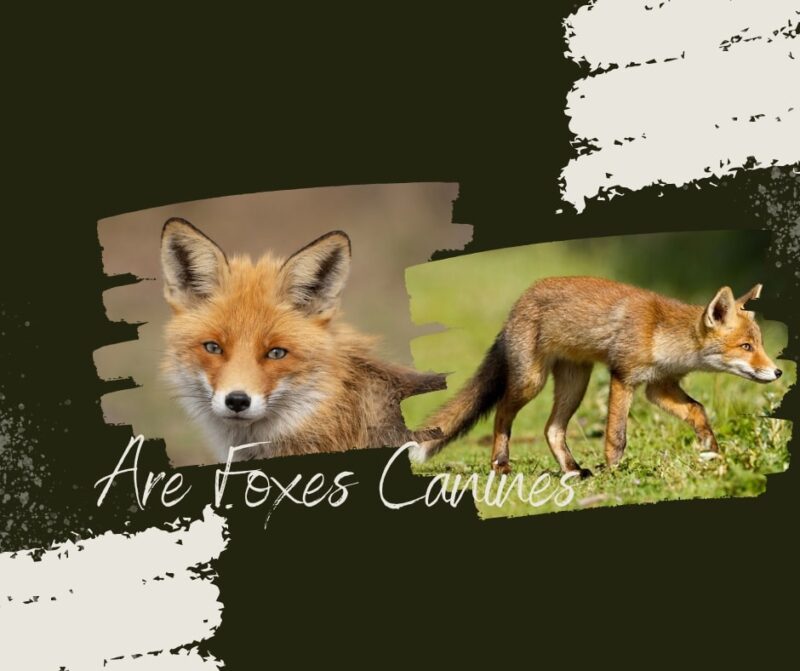Read into the mesmerizing world of the animal kingdom, where nature’s creativity knows no bounds. Amidst this kaleidoscope of life, one creature stands out with its enchanting charm and sly demeanor—the fox. With their cunning behavior and striking appearances, foxes have captured the imaginations of people across cultures. But a lingering question still haunts many curious minds: Are foxes truly part of the esteemed canine family?
Buckle up for a thrilling adventure as we embark on a comprehensive journey into the captivating world of foxes. In this blog post, we’ll delve into their fascinating taxonomy, uncover shared traits with canines, explore subtle differences that set them apart, and encounter the diverse array of fox species that roam the earth. Prepare to have your curiosity ignited and your understanding expanded as we seek to unravel the age-old enigma—Are Foxes Canines? Let’s unveil the truth and embrace the wonder that lies ahead.
The Fox Family – A Taxonomic Overview:

To understand the relationship between foxes and canines, it’s essential to grasp the concept of taxonomy. Taxonomy is the scientific system of classifying living organisms based on their shared characteristics and evolutionary relationships. Foxes are classified as follows:
- Kingdom: Animalia
- Phylum: Chordata
- Class: Mammalia
- Order: Carnivora
- Family: Canidae
The Canidae family, also known as the dog family, hints at the potential connection between foxes and canines.
Shared Characteristics with Canines:
The similarities between foxes and canines are striking, providing strong evidence for their classification within the Canidae family. Let’s explore some shared traits:
Dentition: Like canines, foxes possess a distinctive dental formula with sharp, pointed teeth adapted for tearing flesh. This formula includes incisors, canines, premolars, and molars, ideal for carnivorous hunting.
Hunting Behavior: Both foxes and canines are carnivorous predators with similar hunting behavior, including stalking, chasing, and pouncing on their prey.
Social Structure: Foxes often exhibit social behavior, living in packs or family units, similar to other canines that form cooperative societies.
Communication: Foxes, like canines, communicate using a range of vocalizations, body language, and scent marking to convey messages within their social groups.
Subtle Differences:
While foxes share numerous characteristics with canines, there are some subtle differences that set them apart:
Morphological Differences: Foxes typically have a more elongated body and a longer, bushy tail compared to domestic dogs. Additionally, some fox species have distinct adaptations, like large ears and thick fur, to survive in their specific environments.
Nocturnal Behavior: Many fox species are primarily nocturnal, meaning they are more active during the night, whereas most domestic dogs are diurnal, active during the day.
Genetic Differences: Foxes belong to the Vulpes genus, while domestic dogs belong to Canis lupus familiaris, the subspecies of the gray wolf. Despite being closely related, they are not the same species.
Fox Species Diversity:
The term “fox” encompasses a diverse group of species, each possessing unique adaptations that have allowed them to thrive in various habitats across the globe. Let’s take a closer look at some of the most prominent fox species and their remarkable characteristics:
- Red Fox (Vulpes vulpes): The red fox is undoubtedly the most widespread and recognizable fox species, found across diverse regions of the world. This species boasts a striking red coat, accompanied by a signature white-tipped tail. Known for their adaptability and intelligence, red foxes have successfully inhabited various environments, including forests, grasslands, and urban areas.
- Arctic Fox (Vulpes lagopus): A master of survival in extreme conditions, the arctic fox calls the freezing Arctic regions its home. To withstand the harsh cold, these foxes have evolved with a thick, insulating fur coat that not only provides warmth but also changes color with the seasons. During winter, their fur turns white to blend in with the snowy surroundings, while it becomes brown or gray in the summer.
- Gray Fox (Urocyon cinereoargenteus): Native to the woodlands and forests of North and Central America, the gray fox stands out with its grizzled gray fur. Unlike most other fox species, gray foxes possess unique climbing abilities, allowing them to scale trees and escape predators.
- Fennec Fox (Vulpes zerda): The fennec fox is a true desert dweller, calling the vast Sahara Desert its home. These foxes have adapted to the arid environment with their distinctive large ears, which serve multiple purposes. Not only do the ears help dissipate heat, but they also aid in detecting prey underground.
Conclusion:
As we conclude our enthralling journey into the mesmerizing world of foxes, it becomes evident that these captivating creatures hold a significant place within the esteemed canine family. Through their shared characteristics with canines, such as dentition, hunting behavior, and social structure, we uncover the undeniable link that ties them to their canine relatives.
However, foxes are not mere carbon copies of domestic dogs. Subtle differences in their morphological features, nocturnal behavior, and genetic makeup set them apart as distinct and specialized species in their own right. From the adaptable red fox to the Arctic fox’s incredible survival skills, and the gray fox’s unique climbing abilities, each fox species showcases the incredible diversity of nature’s creations.
As we delve into the intricacies of their taxonomy and explore their remarkable adaptations, we gain a deeper appreciation for the wonders of the animal kingdom. The fox’s enchanting charm and sly demeanor will continue to spark curiosity and captivate the imaginations of people across cultures for generations to come. So let us embrace the truth of their place within the canine family while celebrating the unique marvels that make foxes a symbol of nature’s endless creativity and resilience.
FAQs
Are foxes dangerous to humans?
Generally, foxes are not dangerous to humans. They are shy and elusive creatures that prefer to avoid human interaction. Foxes will typically flee if they encounter people. However, like any wild animal, they may act defensively if cornered or feel threatened. It’s essential to respect their space and observe them from a distance to ensure mutual safety.
What do foxes eat?
Foxes are opportunistic omnivores, meaning they have a varied diet. Their primary food source consists of small mammals, such as rodents, rabbits, and birds. Additionally, they eat insects, fruits, and berries. In urban areas, foxes may scavenge for food in trash bins or feed on human leftovers.
Do foxes make good pets?
No, foxes do not make good pets. While they may look cute and charming, foxes are wild animals with unique needs and behaviors that are challenging to meet in a domestic setting. It is often illegal and unethical to keep a fox as a pet due to their natural instincts and specific care requirements.
How do foxes communicate?
Foxes communicate using a variety of vocalizations and body language. They can produce various sounds, including barks, screams, and howls, to convey different messages such as warning of danger or announcing their presence to other foxes. Additionally, they use tail postures and ear positions to express their emotions and intentions.
Where do foxes live?
Foxes are highly adaptable creatures and can be found in a wide range of habitats, including forests, grasslands, deserts, and urban areas. The specific habitat depends on the species and region. For example, the red fox is widespread and can be found in various ecosystems across the Northern Hemisphere.
How do foxes raise their young?
Foxes are dedicated parents, and their breeding season usually occurs in late winter or early spring. Female foxes, called vixens, give birth to a litter of kits (baby foxes) in an underground den. The vixen nurses and cares for the kits until they are old enough to venture outside the den and learn to hunt with their mother’s guidance.








